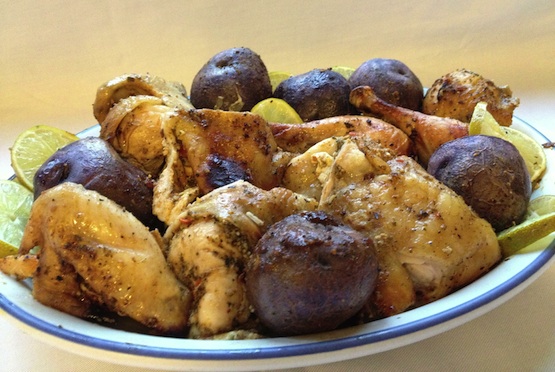Makes 8 servings
- ¼ cup fresh mint leaves
- 6 cloves garlic, roughly chopped
- 3 Tablespoons peanut oil
- 1 Tablespoon salt
- 1 Tablespoon black pepper
- 1 Tablespoon ground cumin
- 1 Tablespoon sugar
- 2 teaspoons smoked paprika
- 2 teaspoons dried oregano
- 4 limes
- ½ Habanero, deseeded and very roughly chopped (see notes)
- a 3 - 4 lb whole chicken
- 2 lb small potatoes, preferably purple potatoes
Special equipment
- food processor
Method
- Spin the first 9 ingredients along with the juice and the zest of two of the limes in a food processor to make a paste. Work this paste under the skin of your bird, especially at the breast and thighs. Coat the exterior of the bird with the remaining marinade, seal in a plastic bag and sit in the fridge overnight.
The next day, preheat the oven to 400°. Stuff the remaining two limes into the chicken cavity, set the bird in a roasting pan, and surround with the potatoes. Roast for ½ hour at the 400° then turn the oven down to 325° and roast for another ½ hour or until the thick of the thighs register 160°. Remove the bird from the oven and let sit about 15 minutes before dividing each breast in half and separating the thighs from the legs. Places the pieces on a serving platter, surround with the roasted purple potatoes and slices of the roasted limes from the cavity.
Notes
- Do not use more than ½ a Habanero. It may be tiny, but it’s ten times hotter than your typical Jalapeño. If you want more of a kick than can be supplied by a Jalapeño but fear the Habanero, try perhaps two teaspoons of cayenne papper.↩
There are many recipes out there for Peruvian-style grilled chicken, some of which require you to stuff an aluminum beer can up the ass-end of a chicken. That doesn’t sound very authentic. Ours is a simple marinade you can make at home and roast in the oven without any special equipment.
Suggestions
- For quantity cookery, we partially debone the bird by removing ribcage and carcass from the breasts and legs. The whole limes then support the structure while roasting, and dividing it into pieces is a snap. This way you get a whole roasted bird surrounded by a crispy skin which you would not get if you divided your bird into parts before putting it in the oven. Need some coaching on removing the ribcage or totally deboning a bird to turn it into a puddle of flesh? Jacques Pepin can help you out there.

